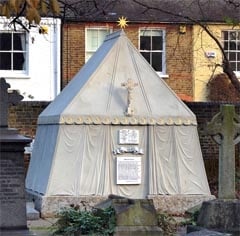Readers projects : Sir Richard Burton Mausoleum
The renovation of the Sir Richard Burton Mausoleum at St Mary Magdalen RC Church in Mortlake, London, was probably the smallest project ever undertaken by architects HOK. But it was also one of the most unusual.
The £26,000 renovation of a mausoleum in the graveyard of a London church is not the kind of project you normally associate with the international architectural practice of HOK. But then, the mausoleum that houses the mortal remains of Sir Richard Burton, best remembered for his translation of the Kama Sutra into English, is one of the country’s more extraordinary memorials.
Even so, HOK might still not have become involved with the Listed structure on the English Heritage ‘At Risk’ register if someone from the London office had not happened to live nearby and been asked to take a look.
Holden Conservation Ltd of W3 had already carried out an investigation into the mausoleum so that the Friends had an idea of what needed doing and how much it would cost in order to start raising money for the work.
As well as general soiling dating back to the time it was built, when the nearby houses and trains would have been burning coal that left carbon deposits, the structure was covered with bird droppings, algal growth and lichen (the lichen was particularly at the back where the structure is shadowed from the sun).
The mausoleum was made originally in the 1890s by Dyke Stonemasons of Highgate. It is a representation of the tent Burton designed for himself and his wife to use when they went exploring. He was 1.8m tall and wanted to be able to stand upright in it. At the apex, the mausoleum is nearly 4m high. It is made of Forest of Dean sandstone of between 75mm and 125mm thick. There are metal ties inside from the time of its construction joined to an iron ring beam at cornice level holding it together.
The Forest of Dean stone was presumably used because it was known to carve well, often being used for garden ornaments and statues at the time. It was also clearly available in large sizes, with each section of the wall and roof made of a single slab of the stone.
The ‘tent’ stands on a plinth of York stone, roughly 3.6m x 3.3m. Inside, the floor is Carrara marble with a dark cabochon, probably of Belgian Black limestone.
At the front, where the plaques are, there was originally a door, which early photographs suggest might also have been made of stone. It would have been used by Isabel, Sir Richard’s wife, to visit until she eventually joined her husband in the mausoleum permanently.
The opening was bricked up for security and safety reasons in the 1970s and remains sealed. Helen Molton, the project architect, says there was some thought of opening it up again, but as nobody was sure what was originally there it was decided to leave it as it is.
The three marble plaques were originally on the door. However, one of them, a scroll mentioning the public subscription that paid for the mausoleum, had gone missing sometime after the doorway was blocked. Holden Conservation have replaced it with a scroll they commissioned from Simon Smith Stone Carving.
At the back is a window, which was designed into the structure because Sir Richard did not like the dark. Martin Holden and his colleague Sarah Gee used it for access to restore the interior.
The inside had been painted sometime after World War Two, analysis of the paint revealed. It was oil-based and had failed badly due to moisture penetrating the walls. It was peeling off, making it relatively easy to remove what was left. Underneath were minute traces of earlier, light brown paint that could have indicated the inside had originally been painted like the inside of a canvas tent. Working round the coffins, which were left undisturbed, the interior was cleaned and redecorated using a breathable lime-based coating.
Air bricks had been built into the original plinth but had become blocked and the inside was damp. New ventilation was installed that can be removed and cleaned from the outside.
Strangely, Holden Conservation discovered that the door had originally had an electrical device on it so that when it was opened, camel bells rang. The circuit included a battery that was recharged using a small wind-generator on the back of the roof.
On the exterior, a Tensid Aquila steam pressure cleaner made short work of algae and lifted the bird mess and general soiling, while three applications of Microtech 25X biocide removed the patches of lichen and should stop it coming back, at least for a while. There was some spalling that was repaired using lime mortars to smooth the edges but not to fill the indents completely, leaving the weathering to show as an integral part of the structure’s history.
To finish off, the mausoleum was given a lime wash maintenance coat that English Heritage insisted on to help keep moisture out. To avoid being too bright it was coloured with synthetic French Ultramarine. And it should stay cleaner now because the trees around the memorial have been cut back. It is anticipated that the lime shelter coat will need renewing about every four years.
Holden Conservation’s work on-site took about nine weeks and they were not there all the time. HOK were involved for three years before the renovation work actually started, helping the Friends of Sir Richard Burton to agree with English Heritage the level of work required, develop a conservation plan, gain planning permission and apply for grants.

